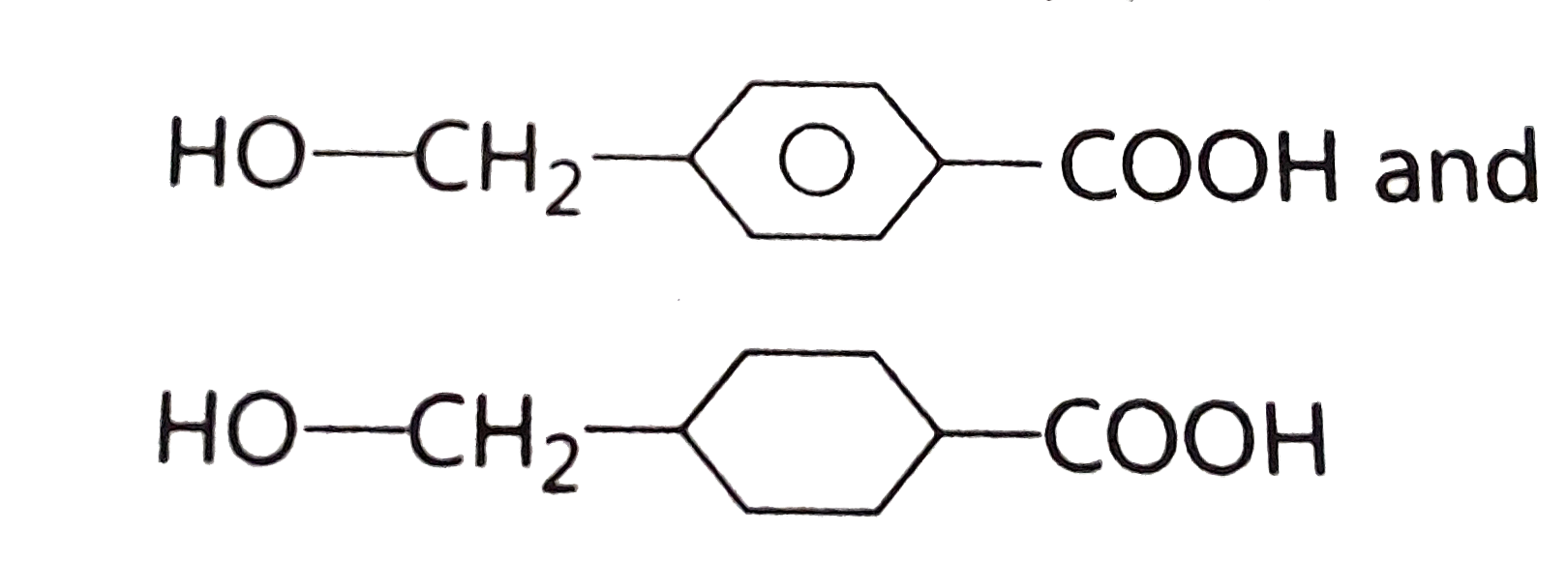Name one polymer formed by step growth polymerisation. Give names of its monomers.
To answer the question, we will follow these steps:
Step 1: Understand Step Growth Polymerization
Step growth polymerization, also known as condensation polymerization, involves the reaction between two different monomers that leads to the formation of a polymer and the elimination of a small molecule, often water.
Step 2: Identify a Polymer Formed by Step Growth Polymerization
One well-known polymer that is formed by step growth polymerization is Dacron.
Step 3: Determine the Monomers of Dacron
Dacron is synthesized from two specific monomers:
1. Ethylene Glycol (C2H6O2)
2. Terephthalic Acid (C8H6O4)
Step 4: Explain the Reaction
The reaction between ethylene glycol and terephthalic acid occurs as follows:
- Ethylene glycol has two hydroxyl (-OH) groups.
- Terephthalic acid has two carboxylic acid (-COOH) groups.
- When these two react, they form ester bonds, and water (H2O) is eliminated as a by-product.
Step 5: Write the Overall Reaction
The overall reaction can be summarized as:
- Dacron Formation:
n(Ethylene Glycol)+n(Terephthalic Acid)→Dacron+n(H2O)
Final Answer
- Polymer: Dacron
- Monomers: Ethylene Glycol and Terephthalic Acid
---
Step growth polymerization, also known as condensation polymerization, involves the reaction between two different monomers that leads to the formation of a polymer and the elimination of a small molecule, often water.
One well-known polymer that is formed by step growth polymerization is Dacron.
Dacron is synthesized from two specific monomers:
1. Ethylene Glycol (C2H6O2)
2. Terephthalic Acid (C8H6O4)
The reaction between ethylene glycol and terephthalic acid occurs as follows:
- Ethylene glycol has two hydroxyl (-OH) groups.
- Terephthalic acid has two carboxylic acid (-COOH) groups.
- When these two react, they form ester bonds, and water (H2O) is eliminated as a by-product.
The overall reaction can be summarized as:
- Dacron Formation:
n(Ethylene Glycol)+n(Terephthalic Acid)→Dacron+n(H2O)
- Polymer: Dacron
- Monomers: Ethylene Glycol and Terephthalic Acid
Topper's Solved these Questions
- POLYMERSBOOK - MODERN PUBLICATIONCHAPTER - POLYMERSEXERCISE - NCERT FILE (NCERT)(In - text Question)
6 Videos
- POLYMERSBOOK - MODERN PUBLICATIONCHAPTER - POLYMERSEXERCISE - NCERT FILE (NCERT)(Textbook Exercises)
20 Videos
- POLYMERSBOOK - MODERN PUBLICATIONCHAPTER - POLYMERSEXERCISE - Practice problems
3 Videos
- ORGANIC COMPOUNDS CONTAINING NITROGEN BOOK - MODERN PUBLICATIONCHAPTER - ORGANIC COMPOUNDS CONTAINING NITROGEN EXERCISE - UNIT PRACTICE TEST
5 Videos
- SOLID STATEBOOK - MODERN PUBLICATIONCHAPTER - SOLID STATEEXERCISE - UNIT PRACTICE TEST
13 Videos
Similar Questions
Knowledge Check
A polymer formed by coordination polymerisation is
Alow density polytheneBhigh density polytheneCnylon-6DdacronAssertion : Dacron is formed by step growth polymerisation of monomer units .
Reason : Dacron fibre is crease resistant .AIf both assertion and reason are true and reason is the correct explanation of assertion .BIf both assertion and reason are true but reason is not the correct explanation of assertion .CIf assertion is true but reason is false.DIf both assertion and reason are false.Polymer formation from monomers in step growth polymerisation starts by
Acondensation reaction between monomersBcoordination reaction between monomersCconversion of monomer to monomer ions by protonsDhydrolysis of monomers.
Polymer obtained by polymerisation of monomers

View SolutionWrite one difference between chain growth and step growth polymerisation. Give one example of each.
View SolutionPolymers are made up of small molecules called monomers. Polymer which are formed by one type of monomer is called homopolymer and which are formed by more than one type of monomers are called co-polymers. Natural polymers are biodegradable whereas synthetic polymers may or may not be. Addition or chain growth polymerization involves the repeated addition of monomers to the polymer chain. The monomers are unsaturated compounds and this type of polymerization takes place by ionic (cationic or anionic) as well as free radical mechanism. Condensation or step growth polymerization involves a series of condensation reactions between twomonomers. Each monomer normally contains two functional groups. Branch chain polymers may be condensation or addition but cross linked polymers are always condensation polymers.
Which of the following is a chain growth polymer?
View SolutionPolymers are made up of small molecules called monomers. Polymer which are formed by one type of monomer is called homopolymer and which are formed by more than one type of monomers are called co-polymers. Natural polymers are biodegradable whereas synthetic polymers may or may not be. Addition or chain growth polymerization involves the repeated addition of monomers to the polymer chain. The monomers are unsaturated compounds and this type of polymerization takes place by ionic (cationic or anionic) as well as free radical mechanism. Condensation or step growth polymerization involves a series of condensation reactions between twomonomers. Each monomer normally contains two functional groups. Branch chain polymers may be condensation or addition but cross linked polymers are always condensation polymers.
Which one of the following monomer is most reactive for anionic polymerization?
View SolutionPolymers are made up of small molecules called monomers. Polymer which are formed by one type of monomer is called homopolymer and which are formed by more than one type of monomers are called co-polymers. Natural polymers are biodegradable whereas synthetic polymers may or may not be. Addition or chain growth polymerization involves the repeated addition of monomers to the polymer chain. The monomers are unsaturated compounds and this type of polymerization takes place by ionic (cationic or anionic) as well as free radical mechanism. Condensation or step growth polymerization involves a series of condensation reactions between twomonomers. Each monomer normally contains two functional groups. Branch chain polymers may be condensation or addition but cross linked polymers are always condensation polymers.
Which one of the following is biodegradable polymer?
View Solution
